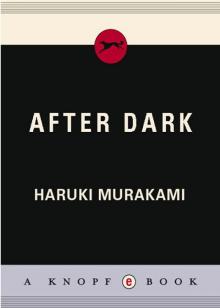- Home
- Haruki Murakami
Absolutely on Music: Conversations With Seiji Ozawa Page 16
Absolutely on Music: Conversations With Seiji Ozawa Read online
Page 16
MURAKAMI: If you ask me, I would guess that, for a very long time, conductors like Karajan had an almost visceral intolerance for the hybridity, the vulgarity, the disunity of Mahler.
OZAWA: I see what you mean. It’s probably fair to say that.
MURAKAMI: We talked before about Karajan’s performance of the Mahler Ninth Symphony, and I agree it’s a wonderful performance. It practically drips with beauty. But if you listen to it carefully, it’s—how should I put it?—it’s not really Mahleresque Mahler. He’s playing Mahler with the same tone he might use for a Schoenberg or a Berg or some other early work of the New Viennese school. In other words, it sounds to me as if Karajan is performing Mahler by dragging him into the area where he himself is at his best.
OZAWA: That is exactly right. It’s especially true of the final movement. Even during the earliest rehearsals, he gave the orchestra the orders he always gave them and made the same kind of music he always did.
MURAKAMI: Instead of producing a Mahleresque sound, he was borrowing the “Mahler” container and filling it with his own music.
OZAWA: Which is why the only Mahler symphonies he played were the Fourth, the Fifth, and this Ninth we’re talking about.
MURAKAMI: I’m pretty sure he did the Sixth, too, and Das Lied von der Erde.
OZAWA: Oh, really? He did the Sixth, too, did he? So that means the ones he didn’t do were the First, Second, Third, Seventh, and Eighth.
MURAKAMI: Which is to say that he chose to record the containers—the works—that were best suited to his own musicality. Maybe he couldn’t quite accept the deep, truly Mahleresque parts of Mahler’s music, which were, in other words, incompatible with orthodox German music. Böhm might have had a tough time with those qualities in Mahler, too. In Germany, especially, Mahler’s music was quite literally wiped out over the twelve long years following 1933, when the Nazis took power, to the end of the war in 1945. That’s a huge gap that put it at a great disadvantage. “A bad tradition” doesn’t begin to encompass the things that happened.
OZAWA: Hmm.
MURAKAMI: Afterwards, it fell to America, and not Europe, to become the powerhouse for the current Mahler revival. In that sense, in some ways, the advantage was given to performers outside of the European home base, or at least the music of someone like Mahler was under no disadvantage there.
OZAWA: It’s not “someone like Mahler”—it is Mahler. He was special in that sense.
MURAKAMI: Speaking of “special,” when I’m listening to Mahler, I always think that there are deep layers of the psyche that play an important role in his music. Maybe it’s something Freudian. In Bach or Beethoven or Brahms, you’re more in the world of German conceptual philosophy, where the rational, unburied parts of the psyche play the most important role. In Mahler’s music, though, it feels as though he is deliberately plunging down into the dark, into the subterranean realm of the mind. As if in a dream, you find many motifs that contradict one another, that are in opposition, that refuse to blend and yet are indistinguishable, all joined together almost indiscriminately. I don’t know whether he’s doing this consciously or unconsciously, but it is at least very direct and honest.
OZAWA: Mahler and Freud lived at just about the same time, didn’t they?
MURAKAMI: Yes. Both were Jewish, and their birthplaces were not far apart, I think. Freud was a little older, and Mahler came to Freud for a consultation when his wife, Alma, had an affair [with the architect Walter Gropius, whom she married after Mahler’s death]. Freud is said to have been deeply respectful of Mahler. That kind of straightforward pursuit of the underground springs of the unconscious may make us cringe—but I think it is probably what helps to make Mahler’s music so very universal today.
OZAWA: In that sense, Mahler rebelled singlehandedly against the sturdy mainstream of German music, from Bach through Haydn to Mozart, and from Beethoven to Brahms—at least until the emergence of twelve-tone music.
MURAKAMI: When you stop to think about it, though, twelve-tone music is extremely logical, in the same sense that Bach’s Well-Tempered Clavier is logical music.
OZAWA: That’s true.
MURAKAMI: Twelve-tone music itself has hardly survived, but different elements of it were absorbed into the music that came afterwards.
OZAWA: Indeed.
MURAKAMI: But this is really quite different from the kind of influence that Mahler’s music has had on later generations. I think you can say that, don’t you?
OZAWA: I do.
MURAKAMI: In that sense, Mahler was really one of a kind.
Ozawa and the Boston Symphony Play the Titan
MURAKAMI: Now I’d like to listen to the same third movement of the First Symphony on a CD you recorded in 1987 with the Boston Symphony.
After the double-bass solo, the funeral march continues with an oboe solo.
MURAKAMI: The sound of the oboe is so different from the one on the Saito Kinen recording we just heard! I’m amazed.
OZAWA: Well, the Boston player doesn’t have that “Miyamoto” sound we talked about before. This one is much milder.
Not just the solo oboe but the whole orchestra sounds much milder than the Saito Kinen.
OZAWA: This part is very mild, too, isn’t it?
MURAKAMI: The sound is unified, and the quality of the playing is high.
OZAWA: Yes, but it could use a little more flavor.
MURAKAMI: I think it’s expressive, and it really sings.
OZAWA: But it’s missing a certain heaviness—a feeling from the countryside.
MURAKAMI: You mean it’s too clean and neat?
OZAWA: The Boston Symphony may have a tendency to make sounds that are too nice.
MURAKAMI: You talked before about bringing out all the little details. Maybe the sound that the Saito Kinen produces is closer to your current conception of this piece.
OZAWA: That’s true. Each individual musician of the Saito Kinen is consciously playing with that in mind. The Boston musicians are thinking about the overall sound of the orchestra.
MURAKAMI: Listening to their sound, I can see exactly what you mean. This is very good-quality, high-level teamwork.
OZAWA: No one does anything to depart from the orchestra’s overall sound. But that’s not necessarily the right way to play Mahler. Getting the proper balance between the two is extremely hard.
MURAKAMI: Maybe that’s why it seems to me so thrilling and interesting these days to hear Mahler played by the irregularly constituted orchestras such as your Saito Kinen or Abbado’s Lucerne Festival Orchestra or his Mahler Chamber Orchestra.
OZAWA: That’s because the members of such orchestras can be bolder. From the moment they get together, each individual of the Saito Kinen is showing off his or her own art: they want the others to see what they can do.
MURAKAMI: So each one is in business for himself.
OZAWA: Of course, this can have its good aspects and its bad aspects. But it fits with Mahler.
MURAKAMI: I guess when the Saito Kinen gets together, it’s like, “All right! This year we’re gonna do the Mahler Ninth!” and they’re all set to go.
OZAWA: Exactly. They arrive with a clear sense of purpose. Almost everybody has studied the score closely.
MURAKAMI: There’s no sense of the routine work of a standing orchestra doing a different program every week.
OZAWA: No, there’s none of that with the Saito Kinen. They’re always fresh. But they may be missing some of the cohesion of a standing orchestra where the members bond together as a unit and can almost read each others’ minds.
MURAKAMI: How does the whole orchestra build a consensus on a piece of music—by going over all the details?
OZAWA: Yes, of course. Most problems can be solved just by the musicians playing their instruments—especially when you’ve got outstanding musicians. An outstanding musician will have a bunch of pockets to draw from. He’ll be watching the conductor and think, “Oh, so that’s how he wants to do this part,” and
pull something out of this pocket over here, and it’s kind of like he’s saying to the conductor, “Okay, then, let’s go with this.” A young musician might not have so many pockets to draw from, of course.
MURAKAMI: Are there some orchestras that are better suited to playing Mahler than other orchestras?
OZAWA: Yes, I think there are. Some orchestras out there are just not up to it technically, where not all the members can play that well. Nowadays, though, I think there are more and more orchestras that can easily handle anything—Mahler, Stravinsky, Beethoven. It didn’t used to be like that. Back when Bernstein was doing Mahler in the sixties, there was very definitely an attitude of “What? He’s doing Mahler? Whoa, that’s tough stuff!”
MURAKAMI: You mean technically difficult?
OZAWA: Yes. In the string sections alone, the demands made on the players push them to their technical limits. So Mahler was composing with an eye on the distant future, writing music like that even though orchestras of his day were probably not of such high quality. He saw his music as a challenge to orchestras, like, “Here, see if you can play this!” So everybody must have been sweating when they performed his music. Nowadays, though, professional orchestras have more of an attitude of “Mahler? Sure, we can play that.”
MURAKAMI: Performance skills have improved that much, have they—even compared with the 1960s?
OZAWA: Absolutely. Over the past fifty years, orchestral technique has advanced to a whole new level.
MURAKAMI: Not just instrumental performance skills but musicians’ ability to read scores closely has also improved?
OZAWA: Yes, I think so. Take me, for example. There was a very definite change in my ability to read a score after I had started reading Mahler in the early sixties, as compared to before.
MURAKAMI: So for you, reading a Mahler score was very different from reading others?
OZAWA: Yes, that’s true.
The Effectively Avant-Garde Nature of Mahler’s Music
MURAKAMI: What is the biggest difference between reading a score by Richard Strauss, for example, and reading a score by Mahler?
OZAWA: At the risk of oversimplifying it, I’d say that if you traced the development of German music from Bach through Beethoven, Wagner, Bruckner, and Brahms, you could read Richard Strauss as part of that trajectory. Of course, he’s adding all kinds of new layers, but still you can read his music in that stream. But not Mahler. You need a whole new view. That’s the most important thing that Mahler did. There were also composers like Schoenberg and Alban Berg in his day, but they didn’t do what Mahler did.
MURAKAMI: As you said a minute ago, Mahler was opening up very different areas than twelve-tone music.
OZAWA: He was using the same materials as, say, Beethoven or Bruckner, but building a whole different kind of music with them.
MURAKAMI: Fighting his battles while always preserving tonality?
OZAWA: Right. But still, in effect he was headed in the direction of atonality. Clearly.
MURAKAMI: Would you say that by pursuing the possibilities of tonality as far as he could take them, in effect he confused the whole issue of tonality?
OZAWA: I would. He brought in a kind of multi-layering.
MURAKAMI: Like, lots of different keys in the same movement?
OZAWA: Right. He keeps changing things around. And he’ll do stuff like using two different keys simultaneously.
MURAKAMI: He doesn’t discard tonality, but he causes confusion from the inside, really shakes things up. That’s how he was, in effect, heading toward atonality. But was he striving for something different from the atonality of twelve-tone music?
OZAWA: Yes, it was different, I think. It might be closer to call what he was doing polytonality rather than atonality. Polytonality is one step before you get to atonality—it means that you use more than one key at the same time. Or you keep changing keys as the music flows. In any case, the atonality that Mahler was aiming for came out of something quite different from the atonality and twelve-tone scale that Schoenberg and Berg were offering. Later, somebody like Charles Ives pursued polytonality more deeply.
MURAKAMI: Do you think Mahler thought he was doing something avant-garde?
OZAWA: No, I don’t think so.
MURAKAMI: Schoenberg and Alban Berg were certainly very conscious of being avant-garde, though.
OZAWA: Oh, very much so. They had their “method.” Mahler had no such thing.
MURAKAMI: So he flirted with chaos, not as a methodology, but very naturally and instinctively. Is that what you’re saying?
OZAWA: Yes. Isn’t that exactly where his genius lies?
MURAKAMI: There was a development like that in jazz, too. In the 1960s, John Coltrane kept edging closer and closer to “free jazz,” but basically he stayed within the bounds of a loose tonality called “mode.” People still listen to his music today—but “free jazz” is little more than a historical footnote. What we’re talking about may be kind of like that.
OZAWA: Wow, so there was something like that in jazz?
MURAKAMI: Come to think of it, though, Mahler had no clear successors. The main symphonic composers who came after him were not Germans but Soviet Russians, like Shostakovich and Prokofiev. Shostakovich’s symphonies are vaguely reminiscent of Mahler.
OZAWA: Yes, very much so. I agree. But Shostakovich’s music is very coherent. You don’t feel the same kind of craziness you do in Mahler.
MURAKAMI: Maybe for political reasons it wasn’t easy for him to let anything like craziness come out. There’s also something deeply abnormal about Mahler’s music. If I had to put a label on it, I’d call it schizophrenic.
OZAWA: Yes, it’s true. The art of Egon Schiele is like that, too. When I saw his pictures, I could really see how he and Mahler were living in the same place at the same time. Living in Vienna for a while, I got a strong sense of that atmosphere. It was a tremendously interesting experience for me.
MURAKAMI: Reading a Mahler biography I see he noted that being director of the Vienna Court Opera was the top position in the musical world. In order to obtain that position, he went so far as to abandon his Jewish faith and convert to Christianity. He felt the position was worth making such a sacrifice. It occurs to me that you were in that very position until quite recently.
OZAWA: He really said that, did he? Do you know how many years he was director of the Court Opera?
MURAKAMI: Nearly eleven years, I think.
OZAWA: For somebody who spent such a long time conducting opera, it’s amazing that he never wrote one of his own. I wonder why not. He wrote all those Lieder, and he was very conscious of the combination of words and music.
MURAKAMI: That’s true, now that you mention it. It’s too bad. But given the kind of person he was, it might have been hard for him to choose a libretto.
The Boston Symphony continues playing.
MURAKAMI: Hmm, listening to them playing like this, the sheer quality of the Boston Symphony Orchestra is almost overwhelming.
OZAWA: Well, I did spend all those years polishing it to make it a world-class orchestra, so the quality ought to be high! The Boston, the Cleveland…the technical accomplishment of orchestras of that caliber is fantastic.
The string section gives elegant voice to the beautiful “pastoral” passage.
MURAKAMI: You can’t get a sound like that out of the Saito Kinen?
OZAWA: Well, after all…
MURAKAMI: It’s just a different sound.
OZAWA: It depends on what the listener is looking for—a harmonious, thoroughly beautiful, finished performance; or one that is not so perfect but has a touch of danger. Such differences can easily arise in Mahler’s case—and especially in this movement, which is so full of such passages.
Ozawa studies the score intently.
OZAWA: Oh, I see, this piece was first performed in Budapest.
MURAKAMI: And was very poorly received, I gather.
OZAWA: I would imagine that the performance
was not very good.
MURAKAMI: Maybe the orchestra couldn’t really understand how it ought to be played.
OZAWA: The first performance of Stravinsky’s Rite of Spring was a fiasco, too, you know. Of course the work itself was partly to blame, but it could well be that the orchestra wasn’t fully prepared to perform it. The piece is full of musical acrobatics. I wish I had asked Pierre Monteux about it directly. We were fairly close for a while.
MURAKAMI: Now that you mention it, Monteux conducted that first performance, didn’t he?
The music comes to the section where the strings and the wind instruments clash head-on and become entangled, like the tails of several complicated dreams (8:43–9:01).
OZAWA: This part is a little crazy, isn’t it?
MURAKAMI: It does contain a kind of madness, doesn’t it?
OZAWA: But in the Boston Symphony’s performance, it all comes together smoothly like this.
MURAKAMI: That’s part of the orchestra’s DNA, isn’t it, to calm down the chaos and fill in the gaps?
OZAWA: The members listen to each other and adjust quite naturally. This is, of course, one of the Boston’s outstanding features.
MURAKAMI: I think it’s very difficult for performers to grasp the similarities between the dissociation in Mahler’s music and the general dissociation experienced by those of us living in the present day. But if you were to perform this same piece with the Boston Symphony right now, don’t you think it would sound very different?

 Sputnik Sweetheart
Sputnik Sweetheart Dance Dance Dance
Dance Dance Dance The Wind (1) and Up Bird Chronicle (2)
The Wind (1) and Up Bird Chronicle (2) Blind Willow, Sleeping Woman
Blind Willow, Sleeping Woman Absolutely on Music: Conversations With Seiji Ozawa
Absolutely on Music: Conversations With Seiji Ozawa Norwegian Wood
Norwegian Wood South of the Border, West of the Sun
South of the Border, West of the Sun Kafka on the Shore
Kafka on the Shore Men Without Women
Men Without Women After Dark
After Dark Hard-Boiled Wonderland and the End of the World
Hard-Boiled Wonderland and the End of the World 1q84
1q84 The Wind-Up Bird Chronicle
The Wind-Up Bird Chronicle Underground: The Tokyo Gas Attack and the Japanese Psyche
Underground: The Tokyo Gas Attack and the Japanese Psyche Vintage Murakami
Vintage Murakami The Elephant Vanishes: Stories
The Elephant Vanishes: Stories Colorless Tsukuru Tazaki and His Years of Pilgrimage
Colorless Tsukuru Tazaki and His Years of Pilgrimage First Person Singular
First Person Singular After the Quake
After the Quake A Wild Sheep Chase
A Wild Sheep Chase What I Talk About When I Talk About Running
What I Talk About When I Talk About Running Birthday Girl
Birthday Girl The Elephant Vanishes
The Elephant Vanishes Norwegian Wood (Vintage International)
Norwegian Wood (Vintage International) Wind/Pinball
Wind/Pinball Norwegian Wood Vol 1.
Norwegian Wood Vol 1. Underground
Underground Colorless Tsukuru Tazaki and His Years of Pilgrimage: A novel
Colorless Tsukuru Tazaki and His Years of Pilgrimage: A novel Killing Commendatore
Killing Commendatore Absolutely on Music
Absolutely on Music